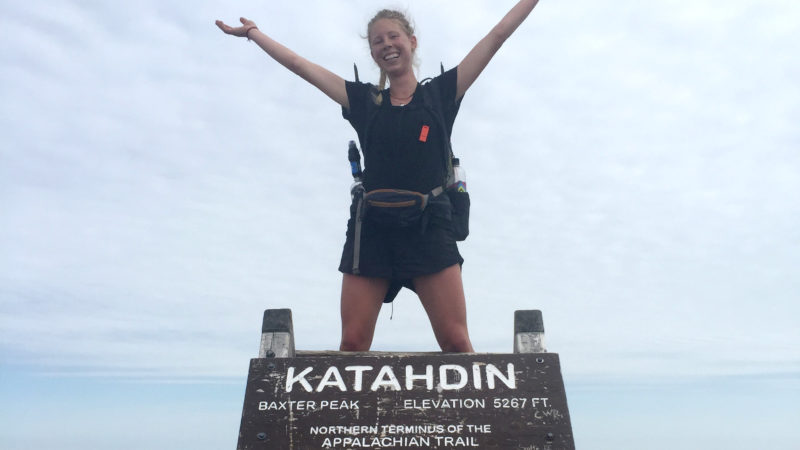Fly to Georgia. Walk home.
Chloë Rowse ’12 spoke with Upper School students this week about her experiences hiking the 2,200-mile Appalachian Trail in 2018. Chloë counseled students to “never underestimate what you are capable of doing.”
Here’s full story:
Fly to Georgia. Walk home.
On the trail with Chloë Rowse ’12
The previous evening’s storm had washed away much of the brush at the mountaintop. Only after half-sliding down a steep slope to the valley below did Chloë Rowse realize that she was no longer on the trail. Shivering, trying her best to overcome feelings of frustration and exhaustion, Chloë hiked back up and, a few minutes later, approached a road crossing where a pickup truck idled in the cold. Here, in the middle of nowhere, were two elderly men distributing cookies and soda to tired hikers. This was one of the many “trail magic” encounters that Chloë experienced during her 2,200-mile hike from Georgia to Maine on the Appalachian Trail.
Chloë embarked on her first extended solo trip at the age of 12. After exchanging letters with a sixth-grade German pen pal, she decided that she wanted to meet her new friend in person. “My parents said, ‘Sure, but you’ll have to pay for the flight yourself,’” says Chloë. “I’m pretty sure they were skeptical about a 12-year-old’s ability to get that kind of money together.” Chloë started a camp for girls that summer and, sure enough, raised enough money to fly on her own to Germany. It was the first of many trips she would take around the world.
Though she had hiked with her family throughout her childhood, Waynflete’s Outdoor Experience program was Chloë’s first introduction to overnight backpacking trips. During her four years in Upper School, she started an Outing Club (featuring weekend “polar dips” at Portland’s East End beach), ran cross-country, and was a member of the Nordic ski team. “I loved the fact Waynflete teams were so welcoming,” she recalls. “Almost everyone played a sport, so there was a wide range of skills. It gave people like me a feeling of confidence—it was OK to play soccer and lacrosse for the first time in high school.”
Chloë attended Colorado College, earning a double major in art and education and competing on the U.S. Women’s National Team at the 2015 World Ultimate Frisbee Championships. After graduating, she moved to Amsterdam where she worked and pursued intensive Dutch lessons. Though she loved the city, she found herself yearning for the mountains of northern New England (after spending four years at college in Colorado, Holland’s flat landscape was particularly jarring). Feeling restless, she decided to return home. Moving meant that she would be between jobs, which opened up an opportunity to do something big. After conducting some extensive research, Chloë decided that she would hike the Appalachian Trail the following year.
Chloë hiked in Patagonia in the fall of 2017, a trip that gave her the opportunity to test her gear setup (excluding food and water, her pack for the Trail weighed only 12 pounds). She completed a Wilderness First Responder course and a self-defense course. Though she was already in strong physical condition, she began an intensive exercise regimen that included cardiovascular and strength training, stretching, balance, and yoga. “I went on some more hikes, but honestly, not a lot,” she says. “It was cold and grey—the middle of winter—so it was easier to motivate myself to train indoors rather than driving a couple hours to the mountains only to freeze. I had no idea that these would be precisely the kind of conditions I would soon be facing.”
Mental training was also critical. Chloë prepared herself for the worst by visualizing situations that might make her want to stop. “I wanted to prove to myself that when the going got really hard, and it was just no fun, that I wouldn’t quit,” she says. “This is what allowed me to finish a challenge that is far more of a mental feat than a physical one.”
In February 2018, Chloë flew to Atlanta. Her father drove to the Springer Mountain trailhead, hiked the first 10 miles in with her, then turned back. She was on her own.
Starting out
It snowed for the first month. Chloë woke each morning to frozen shoes, frozen water, and frozen food. “I would hike a couple of miles with protein bars in my shirt just to get them pliable enough to chew,” she says. These early days of the trip were perhaps the most trying. With freezing temperatures, the possibility of an early overuse injury, and almost complete isolation, half of northbound thru-hikers fail to make it out of Georgia.
Hiking alone every day, all day, Chloë discovered that there actually wasn’t much time for thinking or self-reflection. “You don’t have the energy to think about much more than, ‘Is that a snake or a root? Where am I going to get my water? Is it going to rain? What am I going to eat when I reach the next town?’,” she says. “You wake up every morning, put on your shoes, and just start hiking.” Like most thru-hikers, Chloë had a guidebook that listed water sources, tent sites, road crossings, and nearby towns with grocery stores. Hikers will often hitchhike into towns to restock, stay overnight in a real bed—and take a much-needed shower. Since hitchhiking alone was inadvisable, Chloë stopped less frequently and carried a heavier food load.
Thru-hikers quickly come to recognize their brethren on the trail. “There is a haggard look of hunger, a look of kind of being lost, and of course a smell,” says Chloë. By the end of the trail, most hikers—men in particular—have lost a significant amount of weight. Hikers communicate with each other through shelter log books, which Chloë describes as rudimentary texting. “You would typically write things like ’stopped here for lunch, hoping to catch up with so-and-so soon,’” says Chloë. “It was how you communicated, and how you could tell if someone was no longer on the trail.” It wasn’t unusual for hikers to leapfrog ahead, then fall behind each other on the trail. “You might not see someone you had met for weeks on end, but you could keep in touch through the logs.”
Thru-hikers are christened with a trail name by their comrades. Chloë was christened “Zellow” by a pair of fellow hikers. “They had stopped for lunch beside the trail and said that I flew by them like a gazelle. It was ‘Gazellow’ at first—a combination of gazelle and yellow, for my hair—which was then shortened to Zellow,” she says.
There is a strong sense of camaraderie on the trail. One night, Chloë found herself huddled with a small group in a Smoky Mountain shelter as a blizzard raged outside (at -10 degrees, she got frostbite on the tips of her fingers and couldn’t feel them for several weeks). A hiker had run out of food, and others in the shelter offered up their own supplies to help her get through to the next town. “There was a sense that we were all in this together,” Chloë says. “One of the most special parts of the trail for me was the community.”
At some point during the hike, an utterly simple routine falls into place: rise in the morning, eat, hike all day, eat again, sleep. Exotic gear that inspired excitement at the outset were now simply tools to be used or in some cases discarded. “I encountered people in New England who had recently started heading south,” Chloë recalls. “They were so full of energy, so excited about their gear. You just start to care less about these things as time goes on. I would hike all day in the pouring rain, throw my soaking-wet clothes in the tent, go to sleep, then get up the next morning, put the soaking clothes back on, and start walking again. It just didn’t matter anymore.”
Keeping in touch
Other than an occasional mountaintop text, keeping in regular contact with friends and family via mobile phone was not an option. Hikers are vigilant about preserving their batteries—in Chloë’s case, she used her phone for photography. Chloë carried a spot beacon, a GPS device preprogrammed to send brief status updates or request an emergency rescue, which she used every few nights to update her family on her location. By plugging the coordinates into Google Maps, Chloë’s family could get a satellite view of her precise location in a sea of trees.
Chloë is a vegetarian, and it was sometimes challenging for her to stock up on meat-free (but protein-rich) supplies at stores like Dollar General. Her family sent packages for her to pick up in towns along the trail. To keep weight down, these food shipments carried very specific contents. A chocolate bar was a luxury.
Climate change in action
The 2018 season was one of the worst in the history of the Appalachian Trail, due in great part to the growing impact of climate change. Chloë experienced rapid temperature changes—from extreme cold and snow to hot summer-like days. She passed through burn zones prescribed to combat beetle invasions (parts of the trail were closed later in the season due to forest fires). She experienced unusually severe storms and a tornado brought on by unseasonably warm conditions. Droughts meant that hikers could no longer depend on previously reliable water sources. All these issues—intense storms, wildfires, and drought—were highlighted in a November 2018 study on climate change released by thirteen U.S. federal agencies.
Then there were the ticks. “They were everywhere,” Chloë says. “Deer ticks are the dangerous ones. They’re so tiny—when you’re hiking alone and not showering, they can be really hard to find. For me, Lyme disease was the biggest danger on the trail.”
Chloë had intended to write blog posts at regular intervals during her hike, but this plan quickly fizzled. Her website shows an image of her gear, the departure day with her dad, a few photos of the forest, and her arrival at Mt. Katahdin. “I quickly became lazy about everything except hiking,” she says. “I was happy that I forced myself to keep a personal journal, but I just couldn’t write blog posts for other people.” She did share photo albums from her phone with friends and family when she arrived in a town with a Wifi signal.
Dartmouth surrealism and trail magic
Chloë had some surreal experiences on the trail. Hikers occasionally walk through towns, and she happened to pass through Hanover, New Hampshire on the day of Dartmouth graduation. “I hadn’t showered in weeks and I had been wearing the same clothes for months,” she recalls with a smile. “And here was everyone, done up in their finest clothes.”
It was outside of Hanover where trail magic made one of its many unbidden appearances—a box filled with fresh-baked banana bread, along with a list of town residents offering to host hikers for free. Earlier, Chloë came upon a cooler in the middle of the woods, filled with ice and cold drinks.
Outside of Hanover came the White Mountains, one of the hike’s highlights. Her pace didn’t let up. “I decided that I was going to do the Presidential Range in one day,” she says. “It should have been one of my hardest days, but it wasn’t—I was so excited that I barely noticed the physical challenge. So much depended on my state of mind.” A “bad-mood day” spent walking on flat ground could be more physically exhausting than climbing several big mountains while in a positive state of mind.
Having been warned about the risks of early injury, Chloë had started out in Georgia at a 10-mile-per-day pace. By the time she reached New Hampshire, she was averaging 25–30 miles per day. She was at a peak fitness level and had also become more efficient with her time—eating breakfast while hiking, for example.
Though she spent time with her parents in the White Mountains, Chloë still had weeks and hundreds of miles to go through some of the Trail’s toughest terrain. Entering into Maine’s 100 Mile Wilderness, she was physically and mentally exhausted. She had abandoned her stove in Massachusetts to save weight and was now eating powdered mashed potatoes that she rehydrated with cold water. “I wasn’t tired of the trail—I still loved it—I was just ready to be done,” she says. “I wanted to sleep in a bed, eat real food, wear clean clothes, and not put the same shoes on every day.”
End of the line
Pick up any book about hiking the Appalachian Trail and you will find pages of testimony about feet. By the end of the hike, Chloë’s flattened feet had grown an entire size and she was suffering from plantar fasciitis. Unlike most hikers, however, she had been lucky enough to find a combination of shoes (she went through five pairs), liners, and socks that warded off blisters until the last day of her adventure. She did experience significant foot pain throughout the hike, however. “Every morning, my feet would be so sore that I could barely walk,” she recalls. “This became such a normal part of life that I didn’t even really talk about it with other hikers. It hurt to sit, to stand still—even to lie down. Hiking was actually the most comfortable thing to do.”
Chloë was the 46th thru-hiker to arrive at Mount Katahdin in 2018, a year that saw only 20 percent of thru-hikers finish the entire trail. She had hiked 2,200 miles in 17 weeks.
Reintegrating back into society can be overwhelming experience for AT hikers-hikers. Although the media was awash with discouraging news and divisive politics, Chloë’s experience on the hike had instilled in her a renewed faith in humanity. “I was constantly reminded that there are kind people everywhere,” she recalls. “I met strangers who picked me up on the side of the road and drove me out of their way. Fellow hikers shared their food with me. I had multiple meals paid for by random people I never even met. I was welcomed inside an air conditioned store during a big storm and given food and iced tea. I experienced more kindness, support, and love in those four months than I have at any other point in my life.”
Chloë will be the featured speaker at one of L.L. Bean’s upcoming winter speaker’s series and will speak at Waynflete’s Upper School Assembly in January. She will also share some of her experiences with her grandmother’s book group, whose members closely followed her adventures through her shared photos.
Chloë has continued to run the summer girls camp every year since starting it at age 12, recently transforming it into an overnight program at a camp in Wilton, Maine. She is now considering a change to the program focus. “It was great to be disconnected from everything while I was on the trail, but I know that that was a real privilege,” she says. “Now that I am back, I want to make my summer programs more meaningful for kids who really need it.” Chloë is planning to run five weeks of camp in 2019 and hopes to develop a series of year-round weekly programs for middle school girls.
Would Chloë ever tackle the Appalachian Trail again, as other thru-hikers have done? “Probably not,” she says. “But as for the Pacific Crest Trail…”
Learn more about Chloë’s summer programs at chloerowse.com.




